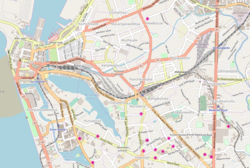| Echelon Barracks | |
|---|---|
| Colombo | |
 First Prime Minister of Independent Sri Lanka Hon. D.S.Senanayaka visiting the 1st battalion of the CLI at the Echelon Square and watching volunteers being trained to handle light machine guns. | |
| Site information | |
| Type | Headquarters building |
| Location | |
| Coordinates | 6°55′56″N79°50′39″E / 6.93222°N 79.84417°E |
| Site history | |
| Built | 1880s |
| In use | 1880s – 1970s |
| Garrison information | |
| Garrison | Ceylon Artillery |
Echelon Barracks was a former military barracks situated in Colombo Fort, Colombo. It was occupied by the newly formed Ceylon Army following independence.
